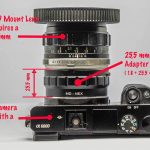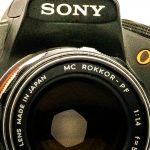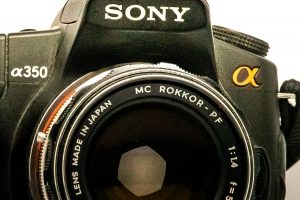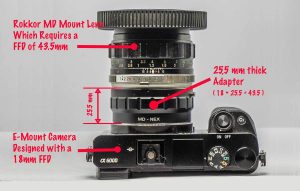Last week, I posted about the alleged difficulty of using a full-frame sensor with the Sony/Minolta anti-shake system. See the post: Can Sony build a true full frame dSLR? I made critical error in my post, when I suggested that the sensor had room to move up and down but not side to side. This is incorrect. The typical 35mm image circle only needs to cover the full-frame sensor from corner to corner, so there would be no room to move the sensor in either direction.
So I was mistaken, but sometimes mistakes can be a positive thing. My error encouraged Bert Pasquale, an optical engineer (and Sony/Minolta SLR user) to write me with his assessment of the full-frame, anti-shake situation. In addition to pointing out my little misconception, he has several innovative ideas on how Sony could deal with the problem.
I asked Mr. Pasquale for permission to reprint his comments and he readily agreed. His remarks follow:
Hey Tom,
Bert Pasquale here, nicetameetcha! 7D & A100 owner… but not for long — the A700 is in stock in my local store since last week, and all the online dealers have them. (Sidebar: Beware ANY low-ball online dealer! – Be sure to Google any potential dealer for reviews before purchasing.)
About full-frame & sensor anti-shake: Note that you get clipping moving either vertical or horizontal; the image circle intersects the corner of 3:2 image rectangle. (Which does make the vertical less sensitive, and luckily that’s the typical hand-held motion.)
But how much movement does a sensor typically need during an exposure? Let’s say a “full-frame” image needed to be stabilized +/-1mm outside the 43.26 mm circle (the diameter of the image circle surrounding a 24x36mm film rectangle) That’s a +/-2.3% shake allowance. (Note: I don’t know how much the current mechanism even allows.)
Let’s think about how much image movement is typically introduced in an exposure? Assuming equal shake, it’s proportional to the focal length. (Of course for short exposures, it’s also proportional to the time.) Taking a few test shots at 1 second at 200mm, I am not shaking more than 1% total of the measured frame. That translates to only 0.42 mm of shift. Even if this was drift in just one direction, I’m still within a reasonable clearance, and if it’s vertical, even less of the image is potentially affected. So, fear not for your ultra-wide angles not working with full-frame sensor-based AS — You would have <<1% shake.
So, what are the implications if you DO move the sensor out of this circle? SLR lenses do not just fall off to zero throughput at Image Radius = 21.63 mm. Though each lens has it’s own characteristics, vignetting often begins before then, and continues out a few mm beyond before reaching zero throughput. (This is especially true when using a near wide-open aperture.) So the final implication of sensor-based AS is this: Some portion of some corners could be somewhat more vignetted than w/o AS. If we were talking about film, this might be an issue, but this is digital imaging, Baby!
What are the solutions digital imaging offers? Here a few:
- Option 1: The camera could, hypothetically, apply an appropriate amount of gain to the corners that went out of the circle to try to make up for lost luminance. It could very intelligently combine general knowledge (Lens ID, focal length and f/# info) and individual frame measurements to compensate. Or, a manual in-camera or computer software user interface could be given. (If the camera embedded the shift info for each corner, and the user could apply the supplied or manual falloff curve correction. (You can already do this in Photoshop manually, as you do for existing “symmetric” vignetting correction.) It would be great to have lens correction built into the capture, anyway (a-la-DxO or the sort.)
- Option 2: The camera could “warn” that possible excessive vignetting occurred, and give the user the option to crop the file right in the camera (manually or automatically), or in software on the computer. Before you even pull the trigger, the camera could observe your stability and let you know the frame is going to be clipped or not so you could frame appropriately, or become more stable. (This would be sweet!)
- Option 3: Limit the AS movement. A user option for given situations could beep, flash or just not move beyond a certain amount, unless willing to crop.
These could be combined to make the AS sensor vignetting issue almost a non-issue. The competition would continue to point out the “superiority of lens AS” (while failing to mention the cost) and Sony will get beat up on discussion boards by people who don’t even have a portfolio. However, the majority of images would be fine — most AS movement would be a fraction of a mm and the corners would show minimal additional falloff. Notice that no one is complaining that the APS-C lenses made by Sigma and Tamron are hopelessly useless on a sensor-stabilized A100. I hope this discussion is helpful.
As an aside: If the “full-frame” sensor used the same pixel size as the A700 (5.3 micron), it would be about a 28.8 effective Mpixel sensor. If it had a 1.1 crop factor (32.7×21.8mm), it would only be 23.8 Mpixels. (If it used the A100’s 6 micron pixels, well, it would only be 23.5 full / 19.5 cropped Mpixels…) (If it used the Canon EOS-1Ds Mark III’s 6.4 micron pixels, it would be 21.0 full / 17.3 cropped Mpixels.)
Bert Pasquale
Optical Engineer
Thanks for sharing your knowledge, Bert. This is exciting stuff! In camera, computer controlled gain? Falloff curve corrections. Sensor based warning that the stability could cause vignetting! Wonder how much of this Sony has considered — and more importantly how much they will actually implement in the Alpha flagship camera. Stick around. it looks like things are going to get really interesting. It looks like its a great time to be a Sony A-mount user!










Tom,
I am not an engineer of any type! I don’t know how the SSS stuff works beyond what I have read here and other sites.
I read Bert’s comments and it made sense but I have one question about sensor size that I have never seen addressed. Why can’t we have a sensor slightly larger then full frame so that no matter where the circle falls it is on the sensor and the camera can auto crop the area not used?
Just a thought from someone that has no idea what happens between when I press the shutter release and when I pull my CF card out! LOL
I already HAVE a Minolta full frame anti-shake digital SLR!
… er, SL-TTL-EVF*. Here’s the details:
Note that the Minolta DiMage 7, 7i, 7ug, 7hi series had matching lens-to-sensor coverage – full frame. Okay, not 35 mm frame, but full-frame matching lens and sensor nonetheless.
Then, later, the exact same lens plus capture sensor size appeared in the Minolta DiMage A1 with sensor-based anti-shake.
Minolta used a severe (+4%?) corner fall-off / vignette compensation filter, but I believe they use it on the entire series – see
http://www.dalibor.cz/minolta/plugin_user_guide.htm
for a sample quote from Dalibor Jelinik:
“…Normally the highest number of a pixel captured is 3,965. But the camera occasionally captures a picture whose maximum value is higher then 3,965, up to 4,095. This is to allow for “vignetting compensation” that occurs when shooting with an aperture of f/2.8. Yes, the camera vignettes at this aperture. The vignetting is hard to see in the corners because the camera multiplies based on a mask to brighten the corner pixels. After this compensation there might be some pixels with values greater than 3,965 (those are the pixels in the corners that were close to maximum before multiplication based on the mask)…”
So, I’m happy with the thought of a Sony Alpha full-35-mm frame SSS anti-shake system, even selectable such that I know that
ON = AS+corner-compensation-filter,
OFF = no filter, for purists.
* SL-TTL-EVF = single lens through the lens electronic viewfinder, an SLR without the R.
Excellent webforum!
http://srubibablo.com
Wow! Good resources here, Enjoyed the visit!
i’m recent here, and only desire to say hello!